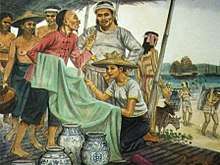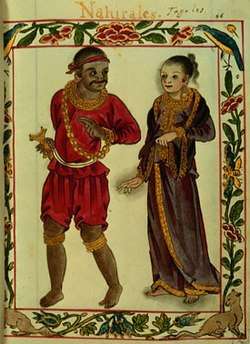Rajahnate of Cebu
| Rajahnate of Cebu Gingharian sa Sugbu | |||||||||||||
|---|---|---|---|---|---|---|---|---|---|---|---|---|---|
| c. 13th century–1565 | |||||||||||||
| Capital | Singhapala[1] (Centered in modern Mabolo district in Cebu City) | ||||||||||||
| Common languages | Tamil language,Old Cebuano, Old Malay | ||||||||||||
| Religion | Syncretic form of Hinduism, Buddhism and Animism (see also Polytheism) | ||||||||||||
| Government | Monarchy | ||||||||||||
| Rajah | |||||||||||||
• ?–1565[2] | Rajah Tupas (last) | ||||||||||||
| History | |||||||||||||
• Sri Lumay founded the Rajahnate | c. 13th century | ||||||||||||
| 4 June 1565 | |||||||||||||
| Currency | Barter | ||||||||||||
| |||||||||||||
| Today part of |
| ||||||||||||
The Rajahnate of Cebu (Cebuano: Gingharian sa Sugbu; Filipino: Kaharian ng Cebu; Malay: Kerajaan Cebu), or simply Sugbu, was an Indianized monarchical polity on the island of Cebu in the Philippines prior to the arrival of the Spanish conquistadors. It was founded by Sri Lumay or Rajamuda Lumaya, a minor prince of the Chola dynasty which occupied Sumatra.[3] He was sent by the Maharajah to establish a base for expeditionary forces, but he rebelled and established his own independent rajahnate.[4]
Summary

According to Visayan folklore, Sri Lumay was a half-Tamil & half-Malay[3] from Sumatra, who settled in the Visayas, and had several sons. One of his sons was Sri Alho, who ruled a land known as Sialo which included the present-day towns of Carcar and Santander in the southern region of Cebu. Sri Ukob ruled a polity known as Nahalin in the north, which included the present-day towns of Consolación, Liloan, Compostela, Danao, Carmen and Bantayan. He died in battle, fighting with the Muslim Moro pirates known as magalos (literally "destroyers of peace") from Mindanao.[5] The islands they were in were collectively known as Pulua Kang Dayang or Kangdaya (literally "[the islands] which belong to Daya").[6]
Sri Lumay was noted for his strict policies in defending against Moro Muslim raiders and slavers from Mindanao. His use of scorched earth tactics to repel invaders gave rise to the name Kang Sri Lumayng Sugbu (literally "that of Sri Lumay's great fire") to the town, which was later shortened to Sugbu ("scorched earth").[6]
Sri Lumay was succeeded by the youngest of his sons, Sri Bantug, who ruled from a region known as Singhapala, which is now Mabolo of Cebu City. He died of disease. Sri Bantug had a brother called Sri Parang who was originally slated to succeed Sri Bantug. But he was a cripple and could not govern his polity because of his infirmity. Parang handed his throne to Sri Bantug's son and his nephew, Sri Humabon (also spelled Sri Hamabar), who became the Rajah of Cebu in his stead.
During Rajah Humabon's reign, the region had since become an important trading center where agricultural products were bartered. From Japan, perfume and glass utensils were usually traded for native goods. Ivory products, leather, precious and semi-precious stones and śarkarā (sugar) mostly came from India traders and Burmese people traders.[3] The harbors of Sugbu (the modern-day Parián district of Cebu) became known colloquially as sinibuayng hingpit ("the place for trading"), shortened to sibu or sibo ("to trade"), from which the modern Castilian name "Cebú" originates. It was also during Humabon's reign that Lapu-Lapu arrived from Borneo, and was granted by Humabon the region of Mandawili (now Mandaue), including the island known as Opong or Opon (later known as Mactan). First contact with the Spanish also occurred during Humabon's reign, resulting in the death of Ferdinand Magellan.[6]
The phrase Kota Raya Kita[7] was documented by historian Antonio Pigafetta, to be a warning in the Old Malay language, from a merchant to the Rajah and was cited to have meant:
"Have good care, O king, what you do, for these men are those who have conquered Calicut, Malacca, and all India the Greater. If you give them good reception and treat them well, it will be well for you, but if you treat them ill, so much the worse it will be for you, as they have done at Calicut and at Malacca."[8]
In reality, this phrase is that of Kota Raya kita, an indigenous Malay phrase of merchants under the authority of Rajah Humabon, with a meaning in English of: "our capital city": Kota (fortress), Raya (great, hence Kotaraya (capital city)), kita (we).
Sri Parang, the limp, also had a young son, Sri Tupas, also known as Rajah Tupas who succeeded Rajah Humabon as king of Cebu.[4]
The Rajahnate was dissolved during the reign of Rajah Tupas by the forces of conquistador Miguel López de Legazpi in the battle of Cebu during 1565.[2]
Modern name usage
There have been proposals to rename the current Central Visayas region, which is dominated by the Cebuano ethnic group, into Sugbu region, the former name of the region prior to Spanish colonization in the 16th century.[9][10]
See also
| Pre-Colonial History of the Philippines |
 |
|---|
| Barangay government |
| Ten datus of Borneo |
| Legendary |
| Suwarnapumi |
| Chryse |
| Ophir |
| Tawalisi |
| Wāḳwāḳ |
| Sanfotsi |
| Zabang |
| States in Luzon |
| Caboloan (Pangasinan) |
| Ma-i |
| Rajahnate of Maynila |
| Namayan |
| Tondo |
| States in the Visayas |
| Kedatuan of Madja-as |
| Kedatuan of Dapitan |
| Rajahnate of Cebu |
| States in Mindanao |
| Rajahnate of Butuan |
| Sultanate of Sulu |
| Sultanate of Maguindanao |
| Sultanates of Lanao |
| Key figures |
| History of the Philippines |
| Portal: Philippines |
- Lapu-Lapu
- Singhapala - the ancient capital of the Rajahnate of Cebu.
- Indonesians in the Philippines
- Hinduism in the Philippines
- History of the Philippines (Before 1521)
- Timawa
- Pintados
Notes
- ↑ https://www.philstar.com/cebu-lifestyle/2009/09/13/504558/aginid
- 1 2 William Henry Scott (1992), Looking for the Prehispanic Filipino: and other essays in Philippine history, New Day Publishers, ISBN 978-971-10-0524-5.
- 1 2 3 The Rajahnate of Cebu, The Bulwagan Foundation Trust.
- 1 2 Jovito Abellana, Aginid, Bayok sa Atong Tawarik, 1952
- ↑ Marivir Montebon. Retracing Our Roots – A Journey into Cebu’s Pre-Colonial Past. p.15.
- 1 2 3 Celestino C. Macachor (2011). "Searching for Kali in the Indigenous Chronicles of Jovito Abellana". Rapid Journal. 10 (2). Archived from the original on 2012-07-03.
- ↑ Approximated as Cata Raya Chita using Italianate orthography.
- ↑ Pigafetta, A., Nancy-Libri-Phillipps-Beinecke-Yale codex, Skelton, R.A. English translation. pg 71
- ↑ http://opinion.inquirer.net/95645/change-name-will-good-philippines
- ↑ http://news.abs-cbn.com/news/06/13/17/should-the-philippines-be-renamed-historian-weighs-in
